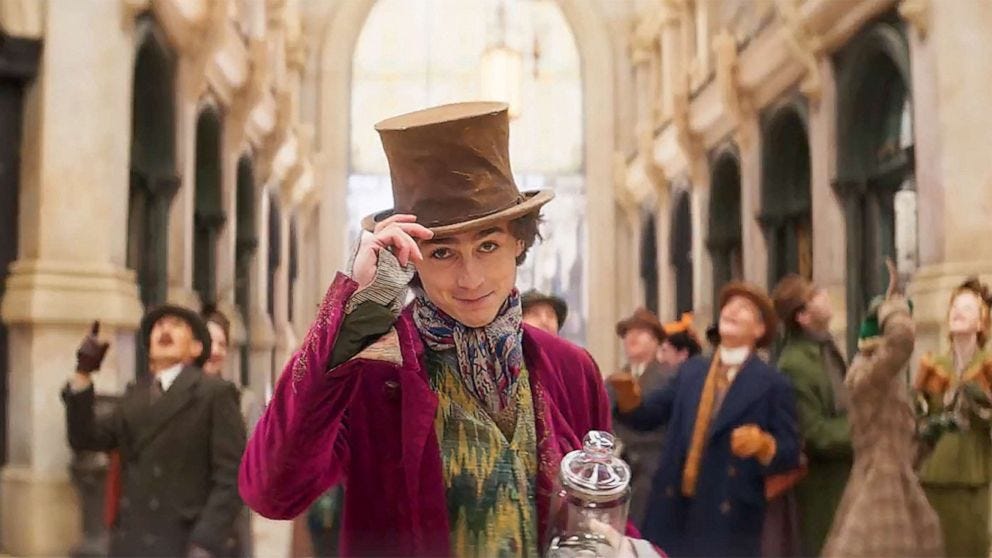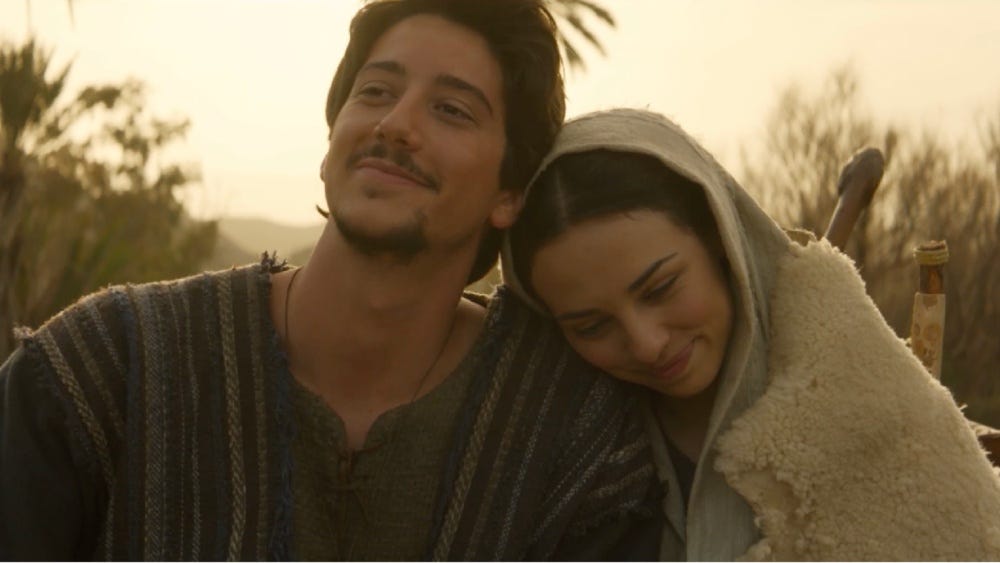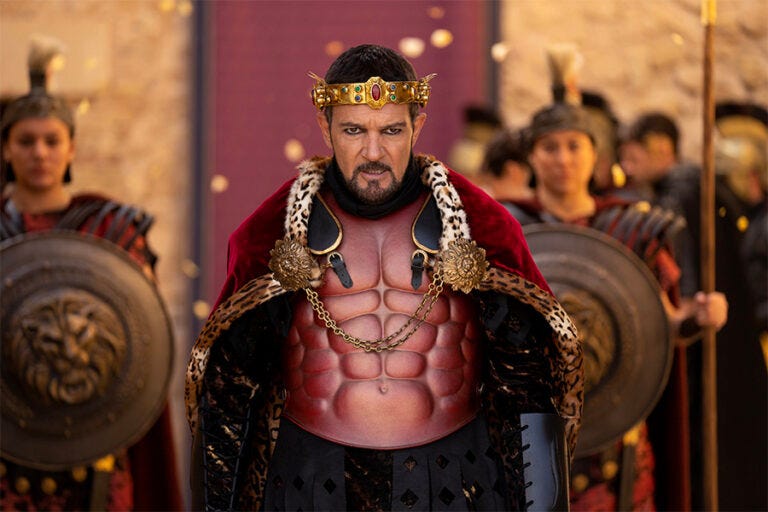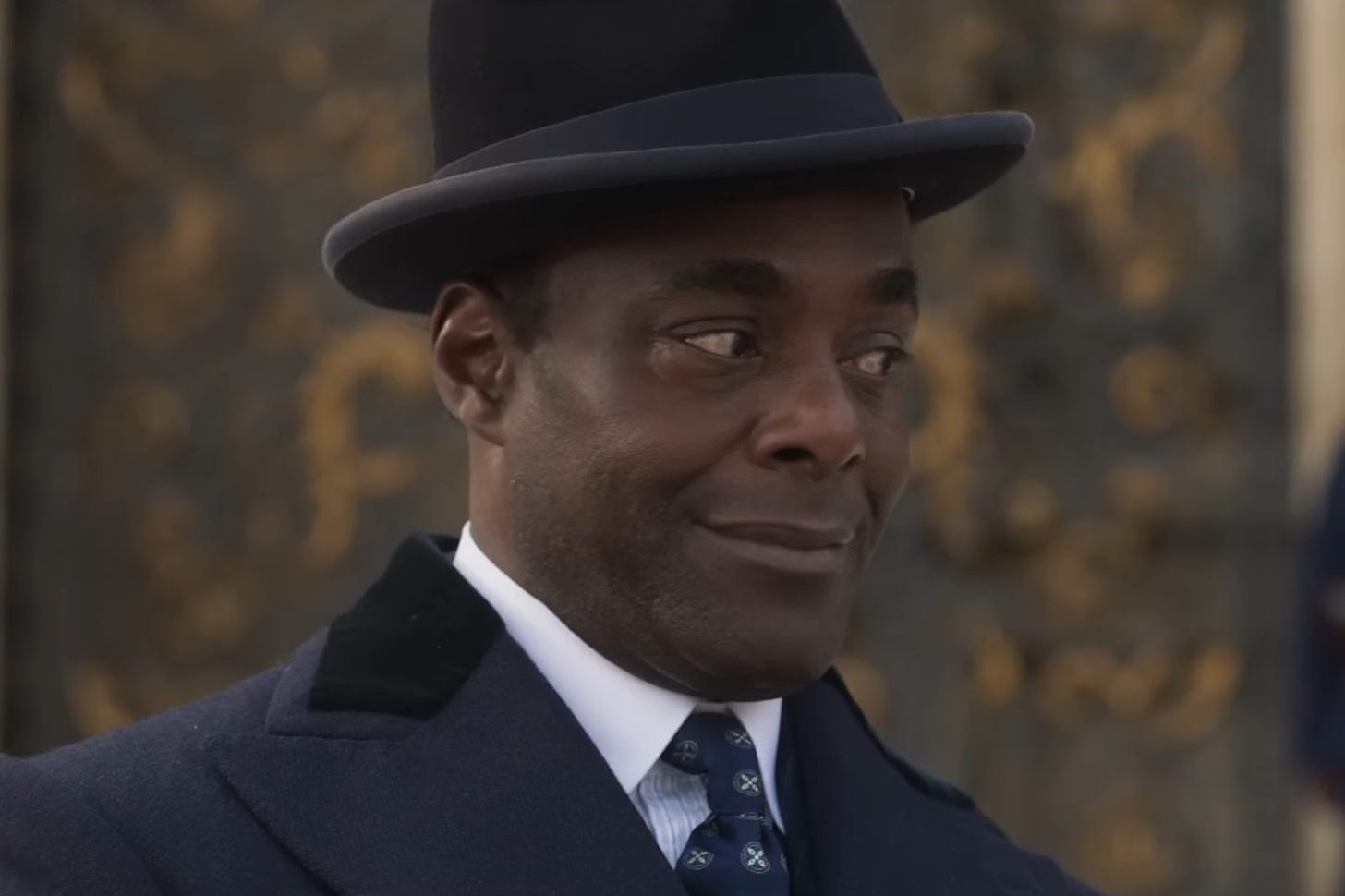White Elephant Film Fest
Two holiday-time film fails. One does it with a bang, the other with a whimper.
Two films. Two origin stories about two larger-than-life figures. This holiday season Paul King’s Wonka and Adam Anders’ Journey to Bethlehem each offer us a prequel of sorts. One focuses on the bon vivant confectioner Willy Wonka. The other offers us the prelude to the birth (depending on your belief system) of the savior of mankind. In Wonka we get a Gen-Z hero for the Gen-Z era, in Journey to Bethlehem we get an infant who gurgles but never speaks (spoiler, the infant was the more compelling).
In Wonka, we get a dead but doting mother, whose presence in Willy’s life is meant to explain his own origins as a self-made man. In Journey to Bethlehem we get a very much alive mother who is more angst-ridden than doting (though she softens postpartum to step into her role as the mother of God).
Prequels and spin-offs are not new. In medieval Europe, the legend of King Arthur spawned hundreds of origin stories, pieces of fan fiction, and all sorts of spin-offs. Willy Wonka is no different than Lancelot, who was the subject of endless (and sometimes prurient) fascination, especially among female aristocrats—and their ladies-in-waiting—in the courts of Europe. The gaps in the source material just left room for poets and storytellers to fill them in with prequels, sequels, and reimagining.
When it came to the life of Jesus in the Middle Ages, there was no less interest in filling in the gaps, but they were largely filled in liturgical dramas which helped revive the art of theatre that had collapsed along with Rome. But vivid adaptations of the Old Testament were also popular among aristocrats (the Jewish heroine Judith being of particular interest, no doubt due to her boldness and defensible homicide of a lecherous creep).
So I can’t wag my finger two strongly at the Marvel universe, since my training in medieval literature and art would render me a hypocrite.
Origins
It was inevitable that we’d be asked to sit through the origin story of Willy Wonka.
Yet Wonka is somehow bleak and blandly affirming, charmless and so desperate to be charming. It confronts the reality of an unfair world while also devising ways around the unfairness that only magic can make happen. It’s escapism that wants to be gritty. The result is an expensive-to-make confection that tastes like a Hershey bar.
By contrast Adam Anders’ feature film debut Journey to Bethlehem (2023) somehow manages to be fairly awful and yet more honest than Wonka with much the same plot: the origin of a salvation figure. Anders’ film has such a threadbare charm that you end up rooting for it like you do the Christmas pageant that your niece has one line in but lasts two hours.
Frankly, the actors in Journey simply had more fun with some aggressively terrible material.
To watch Antonio Banderas as King Herod is the camp event of the year—blending the excesses of British panto, 80s glam rock, and Norma Desmond’s descent into Salome (Sunset Boulevard being the best biblical epic ever made). Every acting choice where Banderas should zig, he zags and zags again. He growls like Eartha Kitt and broods like Orson Welles. He lumbers around his lion-themed throne room like Scar from The Lion King, with enough guy-liner on him to write out the Gospel According to Mark many times over. Close behind is Joel Smallbone as his son Herod Antipas (who is the Herod of the Salome story and of the Crucifixion of Jesus). Smallbone sings the ever-loving heck out of his emo One Republic-like ballad and is clearly enjoying it.
By contrast, Timothée Chalamet’s Willy Wonka bounds about with an endless series of genial facial expressions and upwardly-inflected reassurances. If Banderas is Gloria Swanson, then Chalamet is John Ritter. But John Ritter could make the most hackneyed bit come off as endearing. Chalamet never looks quite comfortable. In fact, his entire presence is apologetic, like an actor who doesn’t want to waste the director’s time at an audition for a role for which they know they’re not right. His sweet and kind face shows nothing of the chthonic imp that was Gene Wilder’s eerily brilliant Wonka.
Chalamet is a hero for the Instagram era. Banderas is a silent film divo (complete with Rudolph Valentino’s eye makeup). Of the two, I’ll take the scenery-chewer any day.
Like an early silent film, Journey to Bethlehem calls attention to its rickety constructedness while Wonka is desperate to tap dance in front of it and pretend nothing had to be made. The musical numbers in both films are inorganic even by the standards of a movie musical. Yet Journey embraces its pastiche soft-rock score, while Wonka pretends like its pastiche of la musique de la gaite Parisienne is somehow high art.
In the end, I really was rooting for Jesus to be born, while I was rooting for Wonka to just settle down in a comfortable mercantile lifestyle.
Wonka? Where?
Like the novel, setting is fairly central to the genre of film. There are production designers whose sole job it is to set a film somewhere and make us believe it. King sets his film in…Paris? We’re led to believe it’s Paris…? There are gendârmes and vaguely art nouveau buildings. The famed overhauling of the city by Baron Haussmann’s seems to be evident. The first locale of any significance we see is an indoor shopping galerie (though more reminiscent of Milan’s Victor Emmanuel gallery than anything particularly French). But is it supposed to be French? It’s in the galerie that the agonizingly earnest young Willy Wonka hopes to set up shop. After all, in an American-made film, the bright-eyed hope is for successful retail.
The fact that King and his team locate the film in Paris is not a fact at all. Because they never land on anything specific. Roald Dahl’s novel Charlie and the Chocolate Factory (1964) is clearly set in Sheffield or Manchester or similar industrial city and reflects something of their post-war malaise. King’s Wonka looks like it was set in Paris Las Vegas. The signs are in English, mercantile architecture is French, accents are all over the place.
King brought together a wonderfully diverse cast, then decided he had to set it everywhere-and-nowhere while forgetting that Paris was (and is) a cosmopolitan city. It’s perfectly historical to have a film set in Paris in the 1910s (?) and have characters of various races, ethnicities, and nationalities and of all social strata among them. The Ameicans in the cast seemed a bit adrift, but they didn’t have to. There were plenty of Americans in Paris in the early 1910s. King might have backed into a fascinating social commentary about colonialism made acceptable if the colonized are financially successful. Or how Black Americans had to flee to Paris to find at least some peace from violent prejudice. But, non.
With the internet able to take us anywhere we want these days, King’s film is set in a Google Images search of “Europe” in the 1910s. Again, it’s difficult, but ultimately needless, to pinpoint the exact time. It makes no difference. A reflection of our quite ambivalent view of history today as just something else to argue over (or to erase or penalize for teaching).
Anders’ Journey to Bethlehem is set in a West Elm or Pottery Barn version of the Holy Land where even burlap cloaks look altogether perfect. I will never forget the petrified garlic hanging from the ceiling of Elizabeth’s house in Hebron just like in a 1980s suburban kitchen (garlic not being native to that region anyway). Joseph’s desert travel wear was pretty fabulous—even if the stripe pattern on his tunic didn’t match up front to back, a sloppy costumer mistake that only drew more attention to how incongruous the clothes of peasant shepherds were with actual sheep herding The clothing of poor Nazarenes looked like what Ina Garten might wear while potting impatiens on her Martha’s Vineyard estate. A drinking game offered itself: Would Mary’s perfect Pantene hair be half-up/half down or in loose tendrils? Did Joseph use enough hair product in this scene? Would Herod Antipas’ horrific Flobee Roman hair cut be bunched in the middle of his head or flattened out?
While the production designers clearly tried, it’s also apparent that they realized that an audience’s minds often fill in details, especially in a film whose subject is so well-known to its target audience that they likely wouldn’t care about the inconsistencies.
In the end, the EPCOT-worthy Palestine proved more convincing, simply because it wasn’t going for authenticity and it knew it. In a film about the power of faith, it was taken on faith that the audience would buy the setting.
Thank You For the Music (Now Take It Back)
Paul King wants Wonka to be a musical, insofar as he includes songs that could have been written by ChatGPT (if you want a window into the future of the tourist musical on Broadway, see Wonka, which will undoubtedly spawn a stage adaptation). As I watched, I was convinced that King watched Baz Luhrman’s Moulin Rouge with his pastiche score and sumptuous, earnestly sophomoric charm. King wants the music and dance to have the hedonistic chaos of Luhrman, but without the oddness. King is producing an LL Bean catalogue of Luhrman’s MTV version of la vie Parisienne.
I frankly am not a fan of Moulin Rouge, but the musical numbers actually worked. At least Luhrman was smart enough to use existing songs of his own generation for the score. And the songs he chose were inherently narrative and somehow advanced the paper-thin plot. The songs in Wonka (by Joey Talbot and Neil Hannon) sound like the high school drama teacher gamely and sufferingly trying to write a pastiche musical for the end of the semester.
The songs were unnecessary.
I can’t remember a single one of them even a few days later. At least in the 1971 film they seemed to fit the acid-trip morality tale that has kept the film salient for over five decades. In King’s Wonka the songs fill time in the name of an ambience (a scene-painting) that simply isn’t necessary because the film isn’t really set anywhere.
Even the nostalgic inclusion of two songs from Willy Wonka and the Chocolate Factory (by Leslie Bricusse and Anthony Newley) felt tacked-on, even if I was grateful for a melody that had some charm.
It wasn’t much better in Journey to Bethlehem, which was a rock musical as written by Stephen Schwartz and later adapted by Air Supply. Each song had a different bland rock beat that seemed to fit the mood of the scene (vengeance, courting, vengeance, courting, angst). It’s clear that the writers watched Moulin Rouge, then read Men are From Mars, Women Are From Venus, then binged the Imagine Dragons catalogue.
The best song title from a musical in a long time is “Can We Make This Work?”, the most therapeutic cry for help since anything in Next to Normal. I was waiting for a song titled “We All Need Boundaries In Our Lives”.
It’s a knee-jerk reaction to see a Swedish songwriting team and think of ABBA (songs for Journey were written by Adam Anders, Nikki Anders, and Peer Astrom). And yet…and yet…the songs featured the same predictable melodies and simple harmonies (such as they were) as the Eurovision champs. But where ABBA embraced a disco ethos that made their songs both corny but hummable fun, the songwriting team for Journey couldn’t settle on a mode. Perhaps inhibited by the super-serious subject, the songs careered from earnest popera to masculinized plotting.
While it was fun to watch Antonio Banderas chew the scenery in his “Be Prepared” knockoff number and Paterson Joseph do much the same in his musical numbers as the evil Slugworth in Wonka, no one really tore into the songs with any memorable relish because they were wafer thin and about as dry.
It’s a Wrap
Neither film is remotely good. However, of the two I’d have to give the nod to Journey to Bethlehem (and by default). Wonka is irksome because it had so much more at its disposal. It wasted all of it. It has a cast that boasts Olivia Colman in a supporting role who does her very best to inject some life into the thing. And, in the end, she’s Mrs. Lovett without the fantastic lines to say and the moral iniquity to be in denial about. King also clearly had a bigger budget and CGI to spare. And it ended up being an Instagram post of a film—something that works really hard to trick the viewer into believing that the maker had a good time.
Journey to Bethlehem had one thing going for it: I couldn’t wait to see where it would go next because I knew I’d be sighing on embarrassed exasperation. But at least I would be participating in something. I got a cardio workout rolling my eyes, at least. I couldn’t even muster that for Wonka.
Journey made big, terrible choices. And made them consistently. Wonka made none. It was safe, bland, and apologetic.
Christian-themed film is relegated to a sort of B-league in American cinema. And I’m not here to defend a genre in which subtlety and intellectual nuance are not the norm. But at least the genre is face-meltingly earnest and upfront about its intentions. Wonka is ultimately an exercise in commercial cynicism. Journey to Bethlehem trades in every cliché you can possibly imagine. And it does so without apology. I knew how the film would end before I even watched it, of course. And I didn’t care.
I didn’t know how Wonka would end, and I didn’t care.






